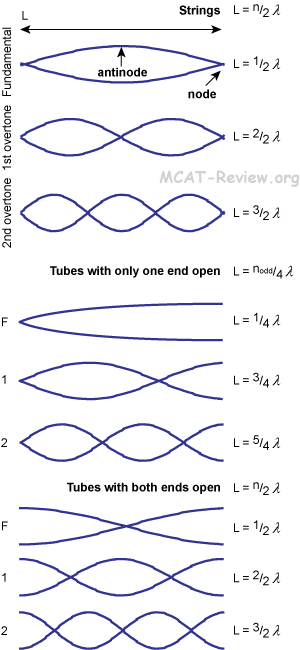|
|
Production of sound
- Sound is produced by vibrations in a medium.
- Sound can not be produced in a vacuum, nor can sound travel across a vacuum.
- Vibrations whose frequency is too low to hear is called infrasound.
- Vibrations whose frequency is too high to hear is called ultrasound.
- Vibrations produce pressure waves that oscilate parallel to the direction of propagation.
- Sound is a longitudinal wave.
Relative speed of sound in solids, liquids and gases
- Speed of sound in solids > liquids > gases.
- The reason why sound travels the fastest in solids is because solids are the most stiff.
- With all else being equal...
- Speed of sound in stiff objects > compressible objects.
- Speed of sound in less dense objects > more dense objects. Even though gases are less dense than solids, sound still travels slower in them because they are too compressible.
- Speed of sound in hot objects > cold objects.
Intensity of sound (decibel units, log scale)
- β = 10 logI/I0
- β is sound level in decibels. I is intensity. I0 is 10-12 W/m2
- Intensity is power per area, or the rate of energy expenditure per area. The unit is W/m2

-
| Intensity | Decibels |
| I0 | 0 |
| 10 I0 | 10 |
| 100 I0 | 20 |
| 1000 I0 | 30 |
- The decibel system is based on human perception. The decibel value for sound with an intensity of I0 is zero - below this intensity, sound is not audible. As intensity increases, our perception of its loudness only increases to a much lesser degree.
Attenuation
- Sound attenuation is the gradual loss of intensity as sound travels through a medium.
- Sound attenuation is the greatest for soft, elastic, viscous, less dense material.
Doppler effect (moving sound source or observer, reflection of sound from a moving object)
- Situations where the observed frequency is higher than the actual:
- Source moving toward stationary observer: fo = fs v/v - vs
- Observer moving toward stationary source: fo = fs v + vo/v
- Source and observer both moving toward each other: fo = fs v + vo/v - vs
- Situations where the observed frequency is lower than the actual:
- Source moving away from stationary observer: fo = fs v/v + vs
- Observer moving away from stationary source: fo = fs v - vo/v
- Source and observer both moving away from each other: fo = fs v - vo/v + vs
- Situations where the observed frequency could be either higher or lower than the actual:
- Source moving toward the observer, but the observer is moving away from the source: fo = fs v - vo/v - vs
- Source moving away from observer, but the observer is moving toward the source: fo = fs v + vo/v + vs
- fo is observed frequency. fs is actual frequency emitted by the source. v is the speed of sound. vo is the speed at which the observer is travelling. vs is the speed at which the source is travelling.
Pitch
- Pitch is the human perception of the frequency of sound.
- Higher frequency = higher pitch.
Resonance in pipes and strings

- Frequencies can be obtained by f = v/λ
- Both strings and pipes open at both ends have L = n/2λ
- Pipes with a closed end have L = (2n-1)/4λ
Harmonics
- The fundamental frequency is called the first harmonic (n = 1).
- The next-up frequency is called the second harmonic (n = 2).
Ultrasound
- Sound has 3 fundamental properties: reflection, refraction, and diffraction.
- Ultrasound imaging is based on the reflection property of sound.
- A source emits ultrasound, which reflects off a surface back into the detector to form an image.
- Ultrasound is sound that is too high in frequency for humans to hear.
|
|
